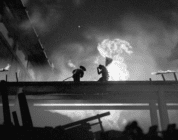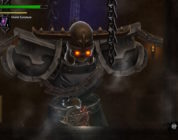There’s a reason that Metroid is one of the most influential video game franchises around, what with tons of spins on the fundamentals of its design showing up in the indie scene to the point of it being commonplace. Metroid titles, usually, are amazing adventures starring one of the most badass women in gaming through alien worlds to single-handedly take out threats to galactic safety. While most will tout the franchises inspiring approaches to exploration, atmosphere, and player progression, Metroid also touts a vast narrative that takes almost every title into its canon. A lot of those narrative developments were felt on Metroid II: Return of Samus on the Game Boy, but that title is definitely starting to show its age. This is where Metroid: Samus Returns, developed by MercurySteam, comes in as a reimagining of that game with completely different features.
From the get go, Samus Returns visually sets itself apart from many other 3DS titles by actually looking awesome with the 3D slider on. Just about every other game I played with the 3D off, but there were several moments in Samus Returns that I found more interesting with that feature on. Colors are vibrant and backgrounds are layered beautifully. Character models are all fantastic and the artistry on display is breathtaking, especially for Metroid fans.
Unfortunately, these visuals just would have looked inherently better on the Switch. Having this game on such a small screen is almost a disservice to the artists that clearly put their passion for Metroid into it. Samus Returns also touts a fairly complex control scheme that has players holding several buttons at once and tapping touch screen buttons to switch beam types. This all would’ve been much easier on a more traditional controller. There isn’t even an option to remap buttons, which is a real shame for players that have some sort of handicap or just don’t like how those buttons are arrayed. It all feels cumbersome, a contrast to the wonderful visuals and gameplay. Of course, for most players its a setup that’s serviceable, just not ideal.
These visuals are accentuated with the game’s dynamic camera. What I felt looked to be a gimmick that would hinder the gameplay upon the game’s announcement, actually became a stand-out feature. The way the camera pans to show points of interest, or to better frame a tense encounter is really cool and rarely gets in the way of player input. Instead of being an entirely hands-off scene, players can switch missile types and hammer away at opponents. Sure, it’s not a lot of input, but it keeps this part of the game’s combat engaging.
Combat in Metroid has typically been about finding the proper weapon and blasting at the right angle or at the right point. Samus Returns keeps that formula and a lot of classic Metroid players will feel immediately at home with it, with the bonus of having full 360 degrees of aiming freedom. However, the inclusion of a melee attack in Samus Returns, gives Samus a way to deal with enemies that get too close. Just about every enemy in the game, including bosses, have a moment where Samus can parry their attacks. This is shown visually with a white spark and auditorily through a particular sound.
Pulling off a successful parry leaves an enemy stunned and super charges Samus next immediate shot on that enemy. Moving away or not following up properly will cancel out that extra damage, so it pays to be a little patient. Really, the only criticism I have for this new mechanic is how it has seemed to affect player flow, which could be a huge turn off for players that are looking to speedrun the title.
I found myself running through past areas, being stopped every step of the way by pesky enemies. Where one should take their time and parry each one, trying to move quickly through an already visited area can be a pain. Add on the amount of damage these enemies can do, even in the late game, resulted in a lot of deaths I didn’t agree with. I did find better success when using the rapid fire Aeion power, but that pulls from a fairly limited resource.
Speaking of Aeion powers, each of the four acquired throughout the game are pretty interesting: one reveals parts of the map in a set area, one creates rapid fire mayhem, one gives Samus invulnerability from most things, and one slows down time. Level design wise, there was mostly gating done with these abilities, where I was hoping to see multiple uses from them in traversal or combat. There’s no real reason to use the time power, aside from crossing gaps that just feel like they’re wasting time. Especially in the last areas of the game, there were several moments where blocks would crumple upon Samus putting her weight on them, but these traps only forced me to go back around and try again. It didn’t add anything to the gameplay and was only designed as a waste of time.
A lot of players I talked to relied on the invulnerability power-up to beat bosses, but I found the rapid fire to be a little quicker as long as my dodges were on point. Bosses in this game are pretty rough, as they have been in past titles. I found myself dying quite a bit through my first playthrough and a lot of moments definitely took some trial and error.
While most of the game’s bosses are variations of the Metroids, which all look awesome with little changes throughout how the fight goes down, the original bosses all had interesting designs. The giant machine, the Diggernaut, definitely had a lot of waiting for cycles to pass, which can be extremely frustrating. Yet, there were fights with Metroids in which I would find a new way to take them down, by using a different beam or finding a new melee counter.
Beam types in Samus Returns are setup in a utility sort of sense. While most Metroid games only have a single beam that gets better over time, Samus Returns makes good use of the Ice Beam and Grapple Beam. The Ice Beam is acquired early on, but was useful clear into the end game to stun foes, get an extra platform, or force bosses out of attack patterns. For example, blasting a Gamma Metroid with a charged Ice Beam shot drops it to the ground, which opens it up for more damage and usually baits out an attack to parry. There are even moments like this on the Omega Metroids, but instead require using the Grapple Beam.
Samus Returns also addresses the backtracking issue in the original title with the addition of teleport stations. This allows Samus to pinpoint where she wants to go to get missed items. Also scattered throughout the map are traditional save stations (the game also handily saves before each fight to allow for repeated attempts), while ammo and health stations are separated. I do wish that save stations could restore health, as it made farming for health pickups necessary to clear some of the bosses.
While I did enjoy my time with Samus Returns, there were a few moments towards the end of the game that just didn’t sit well with me. It’s been brought up by others already (check out Mark Brown’s thoughts on it here), but the end game is filled with enemies, while the original was a much more somber experience. Not only that, but a secret boss was pushed into the end as a classic Metroid villain, one that I really didn’t enjoy seeing as much as I thought I would. This particular boss would’ve been much more interesting as being an optional boss hidden somewhere on the map, or at the end of a boss rush mode or something. As is, it feels like a cheap call back and the fight is fairly annoying to complete.
A lot of these more subtle elements were lost in Samus Returns, making the experience feel less weighted than that early Game Boy title.
Aside from that though, Samus Returns is a must have on the 3DS, one that’s filled with challenge and truly epic moments. It would’ve been much better as a Switch title, but it’s always good to see a traditional Metroid title. There’s always hope that this game will be ported to Switch, but if not, it seems like MecurySteam may not be leaving Samus on her own, at least judging by the game’s ending.
For more information on Metroid: Samus Returns check out the official listing on Nintendo’s website. A copy of the game was purchased by the reviewer.









